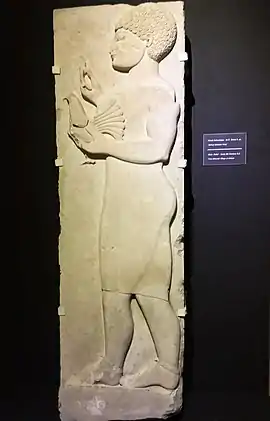 The Gökçeler relief, an example of Greco-Persian art. 5th century BCE. |
| History of art |
|---|
Greco-Persian art, also Graeco-Persian art or Anatolian-Persian is an artistic synthesis between Ancient Greek art and Achaemenid Persian art, which can mainly be seen in the archaeological finds of ancient Anatolia in present-day Turkey.[1] It is part of the evidence of "the presence of Persians in the region".[1] It has been defined as "a peculiar blend of Hellenistic and Achaemenid, or pseudo-Achaemenid, styles" in the Anatolian peninsula under Achaemenid rule.[2]
The Gökçeler relief is an example of this type of art, showing a figure of uncertain ethnic origin, with gifts of "western Anatolian and Greek in origin", however, the clothing he wears are "clearly of Persian influence".[1][3]
The Lycian sarcophagus of Sidon is sometimes presented as an example of Greco-Persian art, although it can also be qualified more precisely as Greco-Anatolian art, since such examples are unknown in the wider Achaemenid Empire.[4]
In Greco-Persian art, the representation of gods is usually the result of an artistic syncretism, combining Greek and Achaemenid characteristics, such as "Zeus-Oromasdes" or "Herakles-Artagnes".[2]
The term "Greco-Persian" applied to the art of Anatolian elite under the rule of Achaemenid Persian, remains a subject of debate, and has been described as too vague or imprecise, hiding the local complexities of the art of the region.[2]

 Achaemenid calvalryman in the satrapy of Hellespontine Phrygia, Altıkulaç Sarcophagus, early 4th century BC.
Achaemenid calvalryman in the satrapy of Hellespontine Phrygia, Altıkulaç Sarcophagus, early 4th century BC.
References
- 1 2 3 Çevirici-Coşkun 2018, p. 128.
- 1 2 3 Versluys, Miguel John. Visual Style and Constructing Identity in the Hellenistic World: Nemrud Dağ and Commagene under Antiochos I. Cambridge University Press. p. 201-202. ISBN 978-1-108-21088-1.
- ↑ Dusinberre, Elspeth R. M. (University of Colorado Boulder) (2013). "Dealing with the Dead". Empire, Authority, and Autonomy in Achaemenid Anatolia. Cambridge University Press. p. 164. ISBN 978-1-139-08755-1.
- ↑ "Greco-Persian Cultural Relations". iranicaonline.org.
- ↑ André-Salvini, Béatrice (2005). Forgotten Empire: The World of Ancient Persia. University of California Press. p. 46. ISBN 9780520247314.
Sources
- Çevirici-Coşkun, Figen (2018). "An Anatolian-Persian tomb relief from Gökçeler in Lydia". Anatolian Studies. 68: 119–130. doi:10.1017/S0066154618000054. S2CID 165412337.